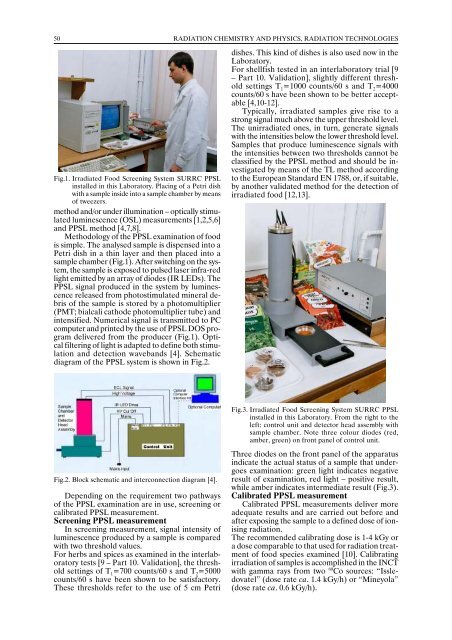annual report annual report annual report annual report 2005
annual report annual report annual report annual report 2005
annual report annual report annual report annual report 2005
You also want an ePaper? Increase the reach of your titles
YUMPU automatically turns print PDFs into web optimized ePapers that Google loves.
50<br />
RADIATION CHEMISTRY AND PHYSICS, RADIATION TECHNOLOGIES<br />
Fig.1. Irradiated Food Screening System SURRC PPSL<br />
installed in this Laboratory. Placing of a Petri dish<br />
with a sample inside into a sample chamber by means<br />
of tweezers.<br />
method and/or under illumination – optically stimulated<br />
luminescence (OSL) measurements [1,2,5,6]<br />
and PPSL method [4,7,8].<br />
Methodology of the PPSL examination of food<br />
is simple. The analysed sample is dispensed into a<br />
Petri dish in a thin layer and then placed into a<br />
sample chamber (Fig.1). After switching on the system,<br />
the sample is exposed to pulsed laser infra-red<br />
light emitted by an array of diodes (IR LEDs). The<br />
PPSL signal produced in the system by luminescence<br />
released from photostimulated mineral debris<br />
of the sample is stored by a photomultiplier<br />
(PMT; bialcali cathode photomultiplier tube) and<br />
intensified. Numerical signal is transmitted to PC<br />
computer and printed by the use of PPSL DOS program<br />
delivered from the producer (Fig.1). Optical<br />
filtering of light is adapted to define both stimulation<br />
and detection wavebands [4]. Schematic<br />
diagram of the PPSL system is shown in Fig.2.<br />
dishes. This kind of dishes is also used now in the<br />
Laboratory.<br />
For shellfish tested in an interlaboratory trial [9<br />
– Part 10. Validation], slightly different threshold<br />
settings T 1<br />
=1000 counts/60 s and T 2<br />
=4000<br />
counts/60 s have been shown to be better acceptable<br />
[4,10-12].<br />
Typically, irradiated samples give rise to a<br />
strong signal much above the upper threshold level.<br />
The unirradiated ones, in turn, generate signals<br />
with the intensities below the lower threshold level.<br />
Samples that produce luminescence signals with<br />
the intensities between two thresholds cannot be<br />
classified by the PPSL method and should be investigated<br />
by means of the TL method according<br />
to the European Standard EN 1788, or, if suitable,<br />
by another validated method for the detection of<br />
irradiated food [12,13].<br />
Fig.3. Irradiated Food Screening System SURRC PPSL<br />
installed in this Laboratory. From the right to the<br />
left: control unit and detector head assembly with<br />
sample chamber. Note three colour diodes (red,<br />
amber, green) on front panel of control unit.<br />
Fig.2. Block schematic and interconnection diagram [4].<br />
Depending on the requirement two pathways<br />
of the PPSL examination are in use, screening or<br />
calibrated PPSL measurement.<br />
Screening PPSL measurement<br />
In screening measurement, signal intensity of<br />
luminescence produced by a sample is compared<br />
with two threshold values.<br />
For herbs and spices as examined in the interlaboratory<br />
tests [9 – Part 10. Validation], the threshold<br />
settings of T 1 =700 counts/60 s and T 2 =5000<br />
counts/60 s have been shown to be satisfactory.<br />
These thresholds refer to the use of 5 cm Petri<br />
Three diodes on the front panel of the apparatus<br />
indicate the actual status of a sample that undergoes<br />
examination: green light indicates negative<br />
result of examination, red light – positive result,<br />
while amber indicates intermediate result (Fig.3).<br />
Calibrated PPSL measurement<br />
Calibrated PPSL measurements deliver more<br />
adequate results and are carried out before and<br />
after exposing the sample to a defined dose of ionising<br />
radiation.<br />
The recommended calibrating dose is 1-4 kGy or<br />
a dose comparable to that used for radiation treatment<br />
of food species examined [10]. Calibrating<br />
irradiation of samples is accomplished in the INCT<br />
with gamma rays from two 60 Co sources: “Issledovatel”<br />
(dose rate ca. 1.4 kGy/h) or “Mineyola”<br />
(dose rate ca. 0.6 kGy/h).
















